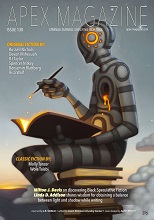“It Rises and Falls and Rises Again” by RJ Taylor
“The First Promise We Break” by Risa Wolf
“Tenure” by Devon Mihesuah
“Nine Theories of Time” by Spencer Nitkey
“Strata” by Benjamin Blattberg
“To Live and Die in Dixieland” by Russell Nichols
“In the Garden of Ibn Ghazi” by Molly Tanzer (reprint, not reviewed)
“An Arc of Electric Skin” by Wole Talabi (reprint, not reviewed)
Reviewed by Victoria Silverwolf
In addition to original fiction and reviews, this issue contains nonfiction articles, reviews, and interviews.
“It Rises and Falls and Rises Again” by RJ Taylor is a surreal tale about people who feel compelled to climb to the top of a mountain, even though this always results in their screaming voices being heard by the villagers below. Even stranger than that, the screams are heard multiple times, as a variety of random objects fall from the summit. The bodies of the climbers are never found. The protagonist follows the path of her lost husband to discover what happened to him.
The author creates a dream-like mood by treating the fantastic content of this story in a matter-of-fact way. The first part of the narrative is intriguing, but the revelation of what awaits at the summit will strike some readers as overly symbolic, in a sort of New Age way.
“The First Promise We Break” by Risa Wolf mixes themes from fairy tales and mythology. A princess of such great beauty that crowds constantly surround her, plucking out strands of hair from her head as souvenirs, is sent to be with a mysterious person, in the manner of the story of Beauty and the Beast. Instead of being a frightening creature, however, he is invisible. In the tradition of many tales, there is a room the princess is never supposed to enter, and a series of seemingly impossible tasks she must perform to find true happiness.
There is much more to the plot than I have indicated above, holding the reader’s interest. The combination of concepts from familiar fairy tales and ancient mythology makes for an original and imaginative story, even if the two types of legends do not always mesh together perfectly.
In “Tenure” by Devon Mihesuah, a man of completely European ancestry fakes his family’s background so he can pretend to be of Native American descent. His goal is to win a tenured position as a scholar of Native American history. He faces supernatural retribution for his deception.
The author writes in a very clear, informal style, maintaining the reader’s attention throughout. The plot is a basic, predictable one, and the story is best appreciated as a heartfelt cry of anger against the misappropriation of Native American culture. One cannot doubt the author’s passion and sincerity.
“Nine Theories of Time” by Spencer Nitkey consists of a series of numbered paragraphs, each one relating a different hypothesis of the structure of time. These varying theories offer multiple ways in which the narrator perceives the death of a child.
This brief work is more of a tragic prose poem than a traditional narrative. Despite the mention of future theories of time that do not yet exist, the speculative content is minimal in this emotionally powerful creation.
In “Strata” by Benjamin Blattberg, an artificial intelligence is more interested in studying geology than in dealing with the human beings living in a post-apocalyptic world. The AI she thinks of as her father, who orbits the Earth, suffers a malfunction that requires repair in space. (In this story, a sophisticated AI is referred to with a gendered pronoun, while simpler ones are not.) She must deal with people, in order to obtain a material necessary for the repair.
The author creates nonhuman characters in a completely convincing manner, while making them complex individuals with vivid personalities. The basic plot suggests a traditional problem-solving story, but there is much more to it than that. The relationship between so-called father and daughter is a complicated one, as much so as in the dynamics of a human family.
“To Live and Die in Dixieland” by Russell Nichols involves a virtual reality simulation of the antebellum South, intended to allow white clients to experience being enslaved. A crisis leads to confrontations among the director of the company, the programmer, and a reporter investigating the situation.
All three main characters are African-American, and the most interesting part of the story concerns their various attitudes concerning the simulation. It might be seen as helping white clients to develop empathy for the experience of slavery, or as allowing them to free themselves from any feelings of guilt. The plot concerns the level of realism of the program. Too little, and it might avoid the true horror of the time; too much, and it might be dangerous to those who use it.
The author confronts the difficult topic of the legacy of slavery in a powerful way. The fact that there are no important white characters in the story avoids portraying them as stereotyped racists, and makes it clear that there is disagreement within the African-American community about this issue. Some readers may find the theme of a simulation that leads to tragedy in the real world overly familiar.
Victoria Silverwolf is about one-quarter Native American.
 Apex #130, March/April 2022
Apex #130, March/April 2022